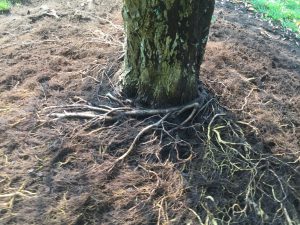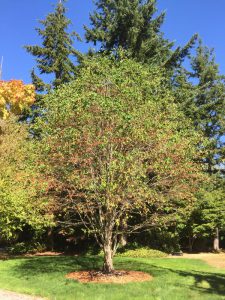We have all heard that mulch is beneficial for landscape trees. However, when applied incorrectly it can lead to more problems for your tree. Last summer we were referred from another local arborist to assess and evaluate a stressed tree.

Our initial visit to a very stressed tree. 5% of the canopy is still green. Note the mound of mulch up against the trunk of the tree.
Trees constantly have bugs, fungi, bacteria, and a host of parasites constantly chewing on them. Many times these are natural associations, and can be beneficial. Here lies the problem; you can treat the symptoms and prune the tree, but ultimately the tree is being removed one dead limb at a time. Pardon the pun, but until the root problem is addressed you are simply treating the symptoms. This is a pervasive issue within the tree care industry, where Tree Services simply are reactive and not proactive. The old adage “when the only tool you have is a hammer, all your problems are solved with nails” certainly applies to chainsaws, tree services, and tree trimming.

Simi emergency scheduling allowed us to work on the tree. After careful removal of the mulch with air excavation equipment, we reveled a secondary root system with many deformed roots.
Now back to the point. Landscape trees are commonly planted too deeply, with the root crown buried below the soil line. Perhaps the landowner knows that mulch is good for trees, or their lawn care maintenance person suggest mulch. However, if the mulch is applied incorrectly or piled on year after year problems will develop. Tree’s have a back up plan, and have dormant buds underneath the bark which allow for regeneration of lost function. This is commonly seen when a tree is removed but the stump continues to sprout. It’s little known that the only thing which determines if these buds become shoots or roots is the environment in which they grow into.
When this happens and the tree is planted too deep, or has a mulch issue the new roots tend to circle around the trunk or major roots. As the tree grows in diameter these circling roots literally start constricting the trees ability to transport water, sugars, starches, and essential elements. The tree is choking. Commonly the tree will show signs of stress such as late leaf formation, early leaf drop, or drought like symptoms (even with irrigation). Pests also take advantage of weakened and stressed trees, but this is another subject on its own.

While it’s difficult, dirty work, these issues can be corrected if caught in time by a skilled arborist assessment. On our initial consultation, it was determined that this was a worthy cause. The options of: cost of tree removal, stump grinding, replacement, and years of growth were weighed. Often times it is more economical to correct the issue to allow all parts of the tree to function properly.
